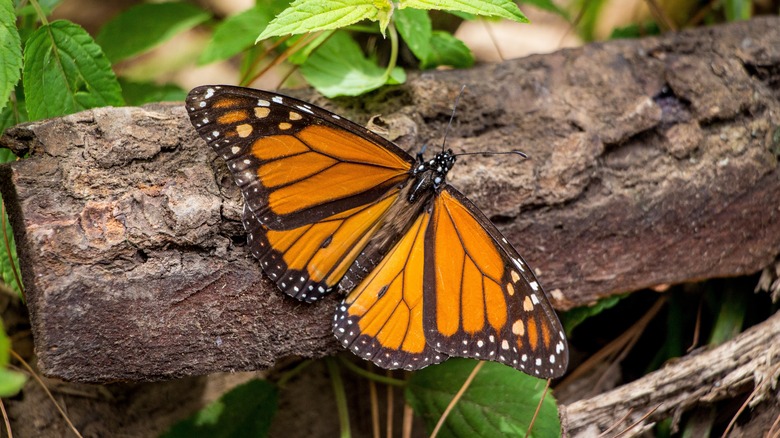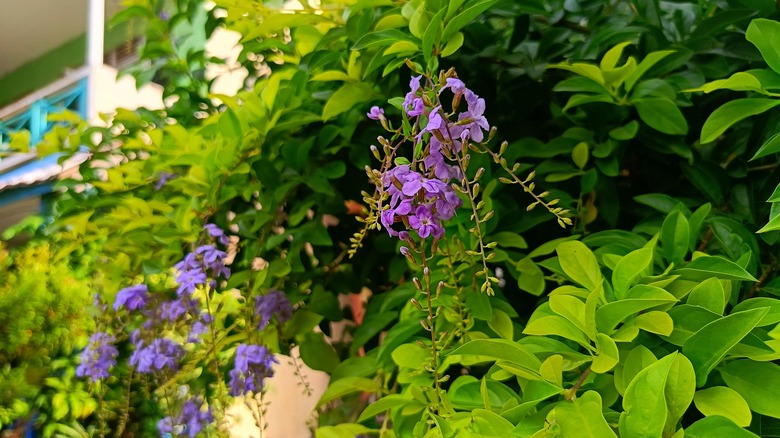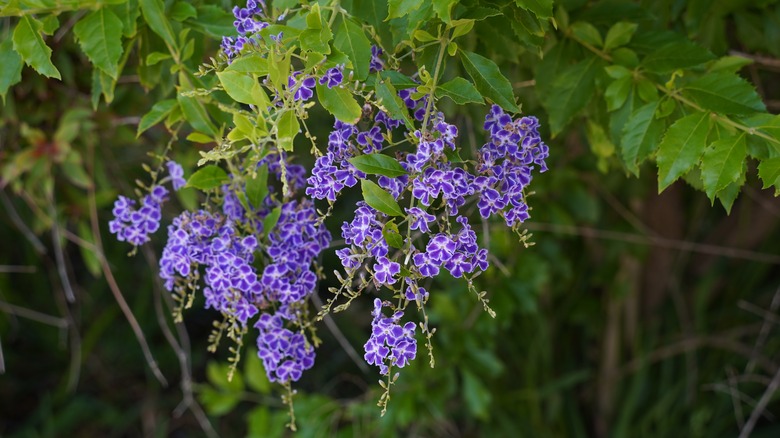The Purple Flowering Tree That Monarch Butterflies Are Drawn To
Many gardeners are aware that the beautiful and vibrant monarch butterflies have been placed on the endangered species list as their numbers have drastically declined over the past few decades. This decline has been attributed to a number of factors including use of pesticides, habitat destruction, and climate change. Monarch butterflies are also important pollinators and help our plants by spreading pollen from one flower to the next. To preserve this important species of butterflies, eco-conscious gardeners are doing their part by creating a garden that helps to attract them and, hopefully, increases their numbers. If you want to attract monarch butterflies to your garden, grow a gorgeous purple flowering tree that's commonly known as golden dewdrop, pigeon berry, or skyflower.
This tree, which has the botanical name of Duranta erecta, has nectar-filled flowers which are loved by monarch butterflies and other pollinators. It's native to subtropical and tropical areas in America and can be grown in USDA zones 9b through 11. However, it's important to note that the berries and leaves of this plant are highly toxic to humans and some animals, even causing death in some cases. Therefore, you need to take care to keep your children and pets away from this tree.
Why Duranta erecta is highly attractive to monarch butterflies
Golden dewdrop commonly grows as a tall, sprawling shrub in colder climates but can reach a height of up to 20 feet in tropical regions. This plant has the most stunning purple flowers that form in large clusters from summer through to fall. There are also some varieties that have blue or white flowers. It's common for monarch butterflies to be drawn to these lovely blooms as the adult butterflies feed on the rich nectar found in the masses of flowers that the plant produces. This means you're likely to see monarch butterflies in your garden right through the summer. You'll also find that a variety of other butterflies will visit your garden when this plant turns on its magnificent floral display.
As well as attracting monarch butterflies, the vibrant flowers of this plant will also lure in other pollinators such as bees. In fact, leaf cutter and mason bees may use the leaves of the plant to build nests. You'll also find that hummingbirds will come to feed on the nectar in the blooms if you plant this small tree or shrub in your garden. The yellow berries that follow the flowers are loved by other types of birds. So, by planting Duranta erecta in your garden, you'll be providing an important food source for a whole range of garden visitors.
Where to plant Duranta erecta for optimum growth
To achieve maximum flowering, which will draw in the most monarch butterflies, you want to plant your Duranta erecta in a sunny position. But, if you get a lot of hot summer days where you live, it's acceptable to give the plant some afternoon shade. This will prevent the plant from drooping a little toward the end of a hot day. The soil needs to be well-drained but you'll need to give your Duranta plenty of moisture during periods of low rainfall. A deep watering at least once a week should be fine. In fact, it's far better to water your outdoor plants heavily once a week rather than every day. You can also apply some mulch to the soil around the base of the plant to help keep more of that moisture in the soil.
Gardeners who live in colder regions can grow this plant as an annual, where it will only reach around 2 to 4 feet in height. Or, you could plant it in a really large pot and bring it indoors over winter. If your soil is fairly loamy and you regularly top up your mulch, your Duranta shouldn't need any supplemental fertilizer. It's advisable to prune your plant to keep a more compact shape, but take care because there are thorns on the stems. Duranta erecta makes a great addition when you want to design your garden to help monarch butterflies thrive.


